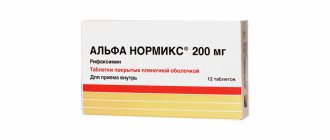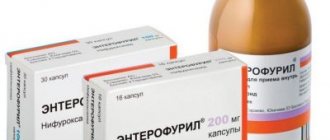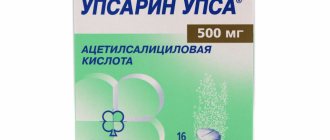The development of pathogenic microorganisms in the intestines often leads to diarrhea, digestive disorders, and inflammatory processes. For treatment in these cases, the antibiotic “Alpha Normix” is used. This is a universal-purpose product, the components of which destroy pathogenic bacteria. The effect is noticeable after the first use.
Pharmacological properties of the drug Alpha Normix
Pharmacodynamics. Rifaximin is a broad-spectrum antibiotic and is a semi-synthetic derivative of rifamycin SV. Irreversibly binds the β-subunits of the bacterial enzyme, DNA-dependent RNA polymerase and, therefore, inhibits the synthesis of RNA and bacterial proteins. As a result of irreversible binding to the enzyme, rifaximin exhibits bactericidal properties against sensitive bacteria. The drug has a wide spectrum of antibacterial activity, including most gram-negative and gram-positive, aerobic and anaerobic bacteria that cause gastrointestinal infections, including traveler's diarrhea. Gram-negative Aerobes: Salmonella spp., Shigella spp., Escherichia coli, including enteropathogenic strains, Proteus spp., Campylobacter spp., Pseudomonas spp., Yersinia spp., Enterobacter spp., Klebsiella spp., Helicobacter pylori ; anaerobes: Bacteroides spp., including Bacteroides fragilis, Fusobacterium nucleatum ; Gram-positive aerobes: Streptococcus spp., Enterococcus spp. , including Enterococcus fecalis, Staphylococcus spp. ; anaerobes: Clostridium spp. , including Clostridium difficile and Clostridium perfrigens, Peptostreptococcus spp. . Absorption of rifaximin in the α polymorphic form in the gastrointestinal tract when taken orally is insignificant (≤1%). The antibiotic acts locally in the intestine, where its high concentration is achieved, significantly higher than the minimum inhibitory concentration for the tested enteropathogenic microbes (after 3 days of therapy, a fecal level of 4000–8000 mcg/g is achieved when taking a daily dose of 800 mg). Due to this, rifaximin has a pronounced antibacterial effect. The use of the drug helps to reduce pathogenic intestinal bacterial flora, which causes some pathological conditions or is involved in their pathogenesis. The drug reduces:
- the formation by bacteria of ammonia and other toxic compounds, which in the case of severe liver disease, accompanied by a violation of the detoxification process, are involved in the pathogenesis of hepatic encephalopathy;
- increased proliferation of bacteria in intestinal microbial overgrowth syndrome;
- the presence of bacteria in the intestinal diverticulum, which may be involved in inflammation in and around the diverticulum and may play a key role in the development of symptoms and complications of diverticulosis;
- antigenic stimuli that, in the presence of genetically determined defects in mucosal immunoregulation and/or protective function, can induce or permanently maintain chronic intestinal inflammation;
- risk of infectious complications during colorectal surgery.
Due to the virtually absent absorption of rifaximin in the gastrointestinal tract, there is no risk of systemic side effects. In numerous clinical studies, rifaximin was always well tolerated by patients. Pharmacokinetics Rifaximin oral absorption is ≤1% based on pharmacokinetic studies in rats, dogs and humans.
The drug is not detected in blood plasma after administration in therapeutic doses (detection limit ≤0.5–2 ng/ml) or is detected in very low concentrations (less than 10 ng/ml in almost all cases) both in healthy volunteers and in patients with damaged intestinal mucosa (as a result of ulcerative colitis or Crohn's disease). Rifaximin found in urine is no more than 0.5% of the dose taken orally. Almost all rifaximin taken orally is found in the gastrointestinal tract, where very high concentrations of the drug are achieved (concentrations in feces of 4000-8000 mcg/g are achieved after 3 days of taking the drug at a daily dose of 800 mg). Comparative pharmacokinetic studies have demonstrated that polymorphic forms of rifaximin are absorbed from the intestine in greater quantities than polymorphic form α.
Pharmacodynamics and pharmacokinetics
"Alpha Normix" belongs to the refampicin group of antibiotics. The active component binds parts of bacterial enzymes, inhibits RNA synthesis, which inevitably leads to mass death of pathogenic microorganisms of different groups. The drug allows you to successfully fight gram-positive and gram-negative bacteria.
The active substance of the antibiotic is not absorbed into the intestines and does not enter the blood. The components act only on the pathogenic intestinal microflora, which minimizes the likelihood of side effects. As a result of taking the drug, it is possible to reduce:
- the level of ammonia and other compounds that are products of the vital activity of microorganisms;
- the concentration of bacteria that are present and multiply in colonic diverticula;
- intensity of inflammatory processes with all accompanying symptoms;
- proliferation of pathogenic bacteria, if it is associated with the syndrome of rapid proliferation of intestinal microflora;
- an antigenic stimulus that can cause chronic inflammatory processes in the intestines;
- risk of infection complications during or after colorectal surgery.
The antibiotic acts primarily on the intestinal microflora. No more than 1% is absorbed through the intestinal mucosa. The active substance of the drug is present in the blood in small quantities after administration. The maximum concentration is reached 3 hours after administration. Reaction products are excreted in feces by 99% and in small quantities (up to 1%) in urine.
Use of the drug Alpha Normix
Suspension Adults and children over 12 years of age: 10 ml oral suspension 3 times daily to 20 ml oral suspension 2–3 times daily (600–1200 mg rifaximin). Children aged 6 to 12 years: 10 ml oral suspension 2–3 times daily to 20 ml oral suspension 2 times daily (400–800 mg rifaximin). Children aged 2 to 6 years: 5 ml oral suspension 2-3 times daily to 10 ml oral suspension 3 times daily (200-600 mg rifaximin). For the treatment of adults and children over 6 years of age, instead of an oral suspension, Alpha Normix can be used in the form of film-coated tablets, 200 mg each. Tablets Adults and children over 12 years of age: from 1 tablet 3 times a day to 2 tablets 2-3 times a day (600-1200 mg rifaximin). Children aged 6 to 12 years: from 1 tablet 2-3 times a day to 2 tablets 2 times a day (400-800 mg of rifaximin). The duration of treatment should not exceed 7 days and depends on the clinical effect in patients. If necessary, repeated courses of treatment can be carried out with a break of 20–40 days. The total duration of therapy depends on the adequacy of the clinical effect in patients. Doses and frequency of administration can be changed on the recommendation of a doctor. Preparation of the suspension The granules for the preparation of the oral suspension are in a hermetically sealed bottle. The bottle must be opened, water added to the mark and shaken well. Add water again until the slurry reaches the specified level. The concentration of rifaximin in the finished suspension is 100 mg per 5 ml. To measure 5, 10 or 15 ml of suspension, add a measuring cup. The suspension remains stable for 7 days at room temperature. Before taking the drug, the bottle must be shaken well.
Alpha normix granules for the preparation of suspension for oral administration 100 mg/5 ml
Active substance: rifaximin
pharmachologic effect
Rifaximin is a broad-spectrum antibiotic from the rifamycin group. Like other representatives of this group, it irreversibly binds the beta subunits of the bacterial enzyme DNA-dependent RNA polymerase and, therefore, inhibits the synthesis of RNA and bacterial proteins.
As a result of irreversible binding to the enzyme, rifaximin exhibits bactericidal properties against sensitive bacteria. The drug has a wide spectrum of antimicrobial activity, including most gram-negative and gram-positive, aerobic and anaerobic bacteria.
The broad antibacterial spectrum of rifaximin helps reduce the pathogenic intestinal bacterial load, which causes some pathological conditions.
The drug reduces:
- the formation by bacteria of ammonia and other toxic compounds, which in the case of severe liver disease, accompanied by a violation of the detoxification process, play a role in the pathogenesis and clinical manifestations of hepatic encephalopathy;
- increased proliferation of bacteria in intestinal microbial overgrowth syndrome;
- the presence of bacteria in the colon diverticulum that may be involved in inflammation in and around the diverticular sac and may play a key role in the development of symptoms and complications of diverticular disease;
- the intensity of the antigenic stimulus, which, in the presence of genetically determined defects in mucosal immunoregulation and/or protective function, can initiate or constantly maintain chronic intestinal inflammation;
- risk of infectious complications during colorectal surgery.
Mechanism of resistance
The development of resistance to rifaximin is caused by reversible damage to the rpoB gene, which encodes bacterial RNA polymerase. The occurrence of resistant subpopulations among bacteria isolated from patients with traveler's diarrhea was low.
According to clinical studies, a three-day course of rifaximin therapy in patients with traveler's diarrhea was not accompanied by the emergence of resistant gram-positive (enterococci) and gram-negative (Escherichia coli) bacteria. With repeated use of rifaximin in high doses in healthy volunteers and in patients with inflammatory bowel diseases, rifaximin-resistant strains appeared, however, they did not colonize the gastrointestinal tract and did not displace rifaximin-sensitive strains.
When therapy was stopped, resistant strains quickly disappeared. Experimental and clinical data suggest that the use of rifaximin in patients with traveler's diarrhea and latent infection with Mycobacterium tuberculosis and Neisseria meningitidis will not be associated with the selection of rifampicin-resistant strains.
Sensitivity
In vitro susceptibility testing cannot be used to determine the sensitivity or resistance of bacteria to rifaximin. At present, clinical data are insufficient to establish cutoff values for evaluating susceptibility tests. Rifaximin was evaluated in vitro against traveler's diarrhea pathogens from four regions of the world: enterotoxigenic and enteroaggregative strains of Escherichia coli, Salmonella spp., Shigella spp.,
non-cholera vibrios, Plesiomonas spp., Aeromonas spp., and Campylobacter spp. The MIC90 for the isolated strains was 32 μg/ml, a level easily achievable in the intestinal lumen as a result of the high concentration of rifaximin in feces. Because rifaximin alpha polymorph has low absorption from the gastrointestinal tract and acts locally in the intestinal lumen, it may not be clinically effective against invasive bacteria, even if these bacteria are sensitive to it in vitro.
Indications of the drug Alpha Normix®
Treatment of gastrointestinal infections caused by bacteria sensitive to rifaximin, including:
- acute gastrointestinal infections;
- traveler's diarrhea;
- syndrome of excessive growth of microorganisms in the intestines;
- with hepatic encephalopathy;
- with symptomatic uncomplicated diverticular disease of the colon;
- for chronic intestinal inflammation.
Prevention of infectious complications during colorectal surgery.
Dosage regimen
The drug is taken orally with a glass of water, regardless of meals.
When treating diarrhea, adults and children over 12 years of age are prescribed 200 mg (1 tablet or 10 ml of suspension) every 6 hours. Treatment of traveler's diarrhea should not exceed 3 days.
For hepatic encephalopathy, adults and children over 12 years of age are prescribed 400 mg (2 tablets or 20 ml suspension) every 8 hours.
To prevent postoperative complications during colorectal surgery, adults and children over 12 years of age are prescribed 400 mg (2 tablets or 20 ml of suspension) every 12 hours. Prevention is carried out 3 days before surgery.
For bacterial overgrowth syndrome, adults and children over 12 years of age are prescribed 400 mg (2 tablets) every 8-12 hours.
For symptomatic uncomplicated diverticulosis, adults and children over 12 years of age are prescribed 200-400 mg (1-2 tablets or 10 to 20 ml of suspension) every 8-12 hours.
For chronic inflammatory bowel diseases, adults and children over 12 years of age are prescribed 200-400 mg (1-2 tablets or 10 to 20 ml of suspension) every 8-12 hours.
The duration of treatment with Alpha Normix® should not exceed 7 days. A second course of treatment should be carried out no earlier than after 20-40 days. The total duration of treatment is determined by the clinical condition of the patients. On the recommendation of a doctor, the dose and frequency of administration may be changed.
Dose adjustment is not required in elderly patients and in patients with hepatic and renal insufficiency.
Rules for preparing the suspension
Granules for preparing a suspension for oral administration are in a hermetically sealed bottle. To prepare the suspension, you need to open the bottle, add water to the mark and shake the bottle well. Add water again until the suspension level reaches the indicated 60 ml mark.
The concentration of rifaximin in the prepared suspension is 100 mg per 5 ml. Shake the suspension well before use. The finished suspension should be measured using the measuring cup included in the package.
Contraindications for use
- diarrhea accompanied by fever and loose, bloody stools;
- intestinal obstruction (including partial);
- severe ulcerative lesions of the intestines;
- children under 12 years of age (efficacy and safety have not been established);
- hereditary fructose intolerance, impaired absorption of glucose-galactose, sucrase-isomaltase deficiency (for the dosage form of granules for the preparation of an oral suspension);
- hypersensitivity to rifaximin or other rifamycins or to any of the components included in the drug.
With caution: renal failure, concomitant use with oral contraceptives, concomitant use with a P-glycoprotein inhibitor such as cyclosporine.
Use during pregnancy and breastfeeding
Data on the use of Alpha Normix® during pregnancy are very limited. Animal studies have shown a transient effect of rifaximin on ossification and skeletal structure in the fetus. The clinical significance of these results is unknown.
The use of Alpha Normix® during pregnancy is not recommended.
It is not known whether rifaximin passes into breast milk. A risk to a breastfed baby cannot be excluded. To decide whether to continue taking rifaximin during breastfeeding, it is necessary to assess the balance of risk for the child and benefit for the mother.
Use for liver dysfunction
No dose adjustment is required in patients with hepatic impairment.
Use for renal impairment
No dose adjustment is required in patients with renal failure.
Use in children
The use of the drug in children under 12 years of age is contraindicated (efficacy and safety have not been established).
Use in elderly patients
No dose adjustment is required in elderly patients.
special instructions
Clinical data indicate that Alpha Normix® is ineffective in the treatment of intestinal infections caused by Campylobacter jejuni, Salmonella spp., Shigella spp., which cause frequent diarrhea, fever, and bloody stool.
Alpha Normix® is not recommended for use if patients have fever and loose, bloody stools. Alpha Normix® should be discontinued if symptoms of diarrhea worsen or persist for more than 48 hours. Other antibacterial therapy should be prescribed. Treatment for traveler's diarrhea should not exceed 3 days.
It is known that Clostridium difficile-associated diarrhea can develop with the use of almost all antibacterial agents, including the drug Alpha Normix®. A potential relationship between Alpha Normix® and the development of Clostridium difficile-associated diarrhea and pseudomembranous colitis cannot be excluded. There is no experience with the use of rifaximin in combination with other rifamycins.
Caution should be exercised when taking rifaximin concomitantly with a P-gp inhibitor such as cyclosporine.
Patients should be warned that, despite the slight absorption of rifaximin (less than 1%), the drug may cause urine to turn reddish. This is due to the active substance rifaximin, which, like most antibiotics in this series (rifamycins), has a reddish-orange color.
If superinfection develops with microorganisms that are insensitive to rifaximin, taking Alpha Normix® should be stopped and appropriate therapy should be prescribed.
Due to the effect of Alpha Normix® on the intestinal flora, the effectiveness of oral contraceptives containing estrogens may decrease after taking it. It is recommended to use additional contraceptive measures when taking Alpha Normix®, especially if the estrogen content of oral contraceptives is less than 50 mcg.
Taking Alpha Normix® is possible no earlier than 2 hours after taking activated carbon.
Granules for preparing an oral suspension contain sucrose, so Alpha Normix® in this dosage form cannot be used in cases of hereditary fructose intolerance, glucose-galactose malabsorption, or sucrase-isomaltase deficiency.
Impact on the ability to drive vehicles and operate machinery
Although dizziness and drowsiness are observed when using the drug Alpha Normix®, it does not have a significant effect on the ability to drive vehicles and engage in activities that require increased attention and speed of psychomotor reactions. If dizziness and drowsiness occur when using the drug, you should refrain from performing these activities.
Before use, consultation with a specialist is required.
The method of administration and dosage regimen of a particular drug depend on its release form and other factors. The optimal dosage regimen is determined by the doctor.
Storage mode, interactions and side effects are indicated in the instructions.
Side effects of the drug Alpha Normix
Analysis of safety data showed that the risk of side effects when using Alpha Normix is very low. These effects are limited primarily to gastrointestinal disturbances (nausea, dyspepsia, vomiting, abdominal pain and cramps), are mild to moderate and usually self-limit without the need for dose changes or interruption of therapy. The drug is practically not absorbed from the gastrointestinal tract, which eliminates the risk of developing systemic side effects. In rare cases, skin reactions such as urticaria may occur, which are likely due to individual intolerance to treatment. The risk of side effects is 0.7–2% of all cases of drug use. Post-marketing surveillance data confirm the above risk assessment and the nature of the observed events.
Contraindications and side effects
The drug is indicated for patients with various diseases, with the exception of:
- all types of intestinal obstruction;
- ulcerative intestinal lesions;
- individual intolerance to the active or auxiliary components of the tablets;
- the appearance of allergic reactions;
- Also, the drug should not be given to children under 12 years of age (by agreement with the doctor, the suspension can be given to children from 2 years of age).
One of the advantages of Alpha Normix antibiotics is the absence or extremely rare occurrence of side effects. However, in rare cases, the following consequences may occur:
- nausea;
- vomit;
- pain in the epigastric region;
- headaches;
- dizziness;
- loss or disturbance of taste;
- increased blood pressure;
- dyspnea;
- weakness, cold sweat;
- Quincke's edema;
- rash;
- diarrhea;
- heartburn.
In most cases, symptoms disappear without additional medications within the first hours after administration. If they persist for several days, the Alpha Normix tablets and suspension are discontinued. Symptomatic treatment and change of course are indicated. To do this, you must consult a doctor.
Special instructions for the use of Alpha Normix
During prolonged treatment with high doses or when the intestinal mucosa is damaged, a small amount of the drug (≤1%) may be absorbed, which can cause urine to turn reddish. This is due to the active substance, which, like most antibiotics of this series (rifamycins), has a red-orange color. Use during pregnancy and lactation. Rifaximin did not cause teratogenic effects in rats and rabbits. Adequate data and well-controlled studies in pregnant women are lacking. Since reproductive toxicity studies in animals do not allow assessment of the possibility of a toxic effect in humans, during pregnancy the drug should be taken only in cases of urgent need and under the direct supervision of a physician. The penetration of rifaximin into breast milk has not been studied, but is expected to be negligible due to very low absorption into the systemic circulation. Therefore, the use of Alpha Normix by women who are breastfeeding is permitted with appropriate medical supervision. The ability to influence the reaction rate when driving vehicles or other mechanisms. Not installed.










